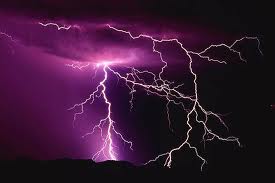Hold On To Those Lightning Bolts of Creativity!
 Writers are familiar with the creative ideas that come at us like lightning bolts. They strike without warning, often at the most mundane or inconvenient times, like when we’re trying to fall asleep, pay bills, or grasp the deeper meaning in Chapter 15 of Leviticus. (Go on, look, I can wait.)
Writers are familiar with the creative ideas that come at us like lightning bolts. They strike without warning, often at the most mundane or inconvenient times, like when we’re trying to fall asleep, pay bills, or grasp the deeper meaning in Chapter 15 of Leviticus. (Go on, look, I can wait.)
But, before we have the opportunity to use these flashes of brilliance (everything from plot twists to character names to dialogue), how do we keep them from fading like a dream upon wakening or from getting lost in our memory mazes?
Here’s what I do. Technophobes need not panic; this is something anyone can master.
I carry a small spiral notepad with me wherever I go. Yes, I could use my smart phone or tablet if I owned either, but I prefer to keep it simple. These inexpensive 3” x 5” pads can fit on my nightstand, in a kitchen drawer, or in my pocket or purse. Whenever I hear a witty phrase or dumb comment, or whenever a perfect pun or play-on-words pops into my head unbidden, I scribble it down.
I’ve noticed another thing about using these notepads: The people I’m with don’t seem threatened or insulted when I pull one out in the middle of a conversation or a sermon. For some reason, writing on a pad appears less impolite than taking out a piece of technology. Maybe because it takes less time, effort and concentration. (Note: Sometimes it does unnerve those who know I’m a writer, but most of the time they’re flattered that I think something they’ve said is novel-worthy.)
You ask, “Then what do you do with all those little notes?”
Glad you asked. First, I enjoy them. There’s nothing that will make me feel more like a writer than to open my pad and read a list like I did this morning:
- Toad Johnson beer-bellied up to the buffet with his stone mason hands.
- miasma (love this word! must use it soon)
- inconsistent eye contact, shifty
- Whirligigs and weeds filled covered their sparse (or scrappy or mangy?) lawn.
- book, line, and stinker?
- (golfer) dog-legged to another topic
- Lovina Avalon
Next, I tear off these pages of mini lightning bolts and put them under my paperweight near my laptop. At least once a week, I go through them, adding them to the appropriate file in a folder called “Slush.” The document files in the Slush folder are:
- Action Verbs and Words
- Author Quotes
- Character Development
- Character Names
- Interjections
- Phrases and Description
Having them in one Slush folder gives me easy access.
Once I’ve incorporated one of these literary scraps in an article or book, I code it so I don’t repeat it. For instance, for my novels Party of One and Double Header, I add Po1 or DH to the beginning of the filename. Helps me find them when I sort the list, too.
In addition to my scribbled odds and ends, I save articles and pictures that pertain to each project. I store hard copies in the Current Project files in my desk drawer. Inside each of these files is an individual folder for Character, Setting, and Story & Plot. The contents looks like what you might find in a scrapbook. Here are a few of the things that add dimension to my stories and characters:
- Pictures of actors or models that resemble my fictional characters
- Recipes one of my characters might use
- Home décor photographs
- History of the town where they live
- Common activities in the part of the country where they live
- Wardrobe, hairstyle, make-up
- Political issues that may define them
- Work place environment
- Church and church leaders
The more I get to know my characters, the better I’ll know how they will behave and interact with one another.
A few months back I was conversing with my granddaughter, Jess and her friend, Tiffnee.
Jess said, “Tiffnee! You’ve got to see what my grandmother has in her purse.” She looked at me and said, “Show her, show her! I know it’s in there.”
“Show her what?” I asked.
Jess said. “You know, your notepad.”
I reached into my purse and pulled one out. “This?” I asked, surprised they were so interested.
“Told you!” Jess said. “And it’s always a different color!”
“Really? Like wow,” Tiffnee said, fingering the glossy red cover. “Ooh, it has lines, too. Like wow! What, like, do you do with it?”
“Anything she wants!” said Jess.
“Like, write lists and stuff?” Tiffnee asked. “And play tic-tac-toe or hangman?”
“Mostly, I record people, places and things I want to remember,” I said.
“Like cool,” said Tiffnee, handing it back to me.
“I know,” said Jess, all puffed up and smiling like I made her proud.
(And there I was wishing I owned an iPad.)
I flipped open my bright shiny notepad and grabbed my pen. Filled with new confidence, I jotted down words faster than I could, like, spell, like, Tiffnee, like wow, like cool.


The Conversation
What a great article. When I started writing, I’d mark passages in books I owned when I thought the author had a clever description of a character or setting or some emotional moment, but I always wondered how I’d find them when I needed a little inspiration. I finally remembered that I write database software. (Duh!) So I wrote a simple database in which to key the entries. Now, anytime I need a jolt of creativity, I type in a few keys words for the topic I’m searching, and out pops the entries I’ve made that match the criteria. Very handy learning tool. Will be happy to share it with you if you wish.
And I wouldn’t have to give up my spiral pads? Jim, that would be great. Thanks.
Clarice, you never cease to educate, inspire, and entertain me.
Wow. “Educate, inspire, and entertain.” Yikes! Now the pressure’s on. 🙂 Thanks, Janet.